The Best Primers for Painting Furniture (and How to Choose the Right One)
There are a lot of primers on the market, and it can be tough to choose the right one. This guide will help you pick the best primer for painting furniture – whether you’re working with wood, laminate, or IKEA furniture. Plus, learn how to apply it like a pro!
Painting furniture is a great way to give an old piece a new lease on life. But before you start painting, it’s important to prime the surface. Also, learn more about the different types of paint for furniture here!
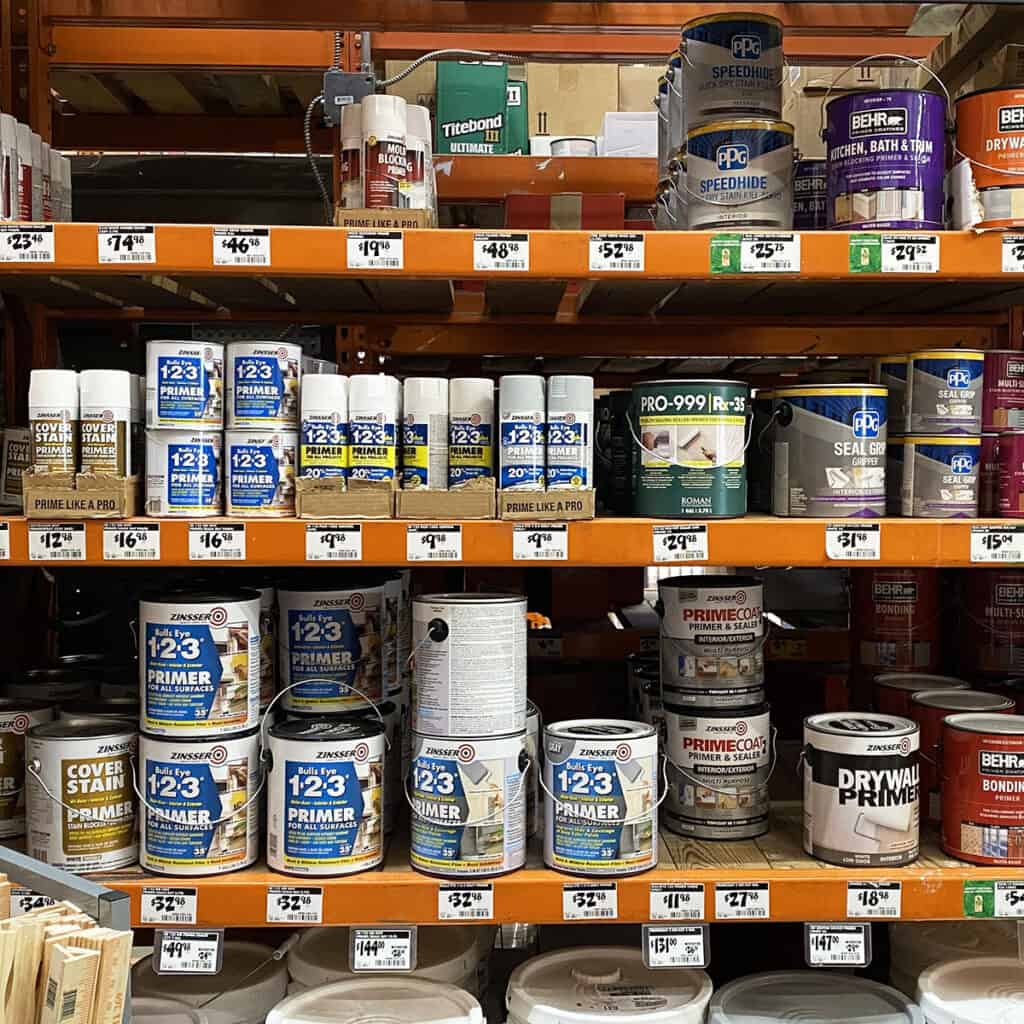
Priming helps to prevent bleedthrough stains, and it also provides better coverage. Additionally, priming helps to cover wood grain texture and gives the paint something to stick to. Let’s dive in!
As an Amazon Associate, I earn from qualifying purchases. I also may earn from other qualifying purchases with other companies or get free product to review and use. All opinions are my own.
Do I need to prime before painting furniture?
One of the most important steps in painting furniture is to apply a primer before painting. When you paint furniture without priming it first, there are a few problems that can come up.
Primer creates a bond between the paint and the furniture.
On wood furniture, it helps to prevent tannin bleed-through that can stain your paint. It also prevents scratches and uneven coverage in the paint.
When you skip this step, you may find that your paint doesn’t stick well to the furniture, that it scratches easily, or that the color and/or sheen is uneven.
Primer really is essential for a good paint job. So if you’re thinking about painting furniture without primer, you might want to reconsider!
Learn more about the importance of priming wood for painting plus tips here.
The Best Primer for Painting Furniture
But what’s the best primer for painting furniture? It depends on what you’re painting, what paint you’re using, and what you’re wanting to get out of it.
Best Primers for Wood Furniture
When painting wood furniture, it’s important to choose the right primer. Primer will help paint stick to wood, but also, it will prevent tannin bleed through stains from coming through your paint.
A good primer will also give you better coverage so you don’t use as much paint, and better coverage so you can’t see the wood grain variations through the paint.
- BIN shellac based primer is a good option for preventing tannin bleedthrough, which can occur when tannins in the wood come through the paint. This type of primer also provides good coverage and helps create an even sheen in your final paint. However, it’s important to note that shellac based primers are stinky, and need to be cleaned up with denatured alcohol or ammonia (which also stinks bad!)
- Another great primer for wood furniture is Zinsser Bulls Eye 1-2-3. This primer also helps to prevent tannin bleedthrough and provides good coverage. It’s much easier to work with than shellac based primers, though it doesn’t have quite the same power to prevent bleedthrough. It’s waterbased, so cleanup is easy with soapy water, and it doesn’t have harsh fumes.
Note: I like to use clear shellac as a primer on my furniture. It works great with mineral, acrylic and chalk based paints. I haven’t tested it with all types of paint.
Also, check out the best spray primer for wood here.
| BIN Shellac Based Primer | Clear Shellac | Zinsser 123 | |
|---|---|---|---|
| Adhesion | Excellent | Excellent | Good |
| Prevents Bleedthrough | Excellent | Excellent | Good |
| Coverage | Excellent | No | Excellent |
| Odor | Strong Odor | Strong Odor | Low Odor |
| Cleanup | Denatured Alcohol or Ammonia | Denatured Alcohol or Ammonia | Soap and Water |
| Application | Brush, Roll, Spray Can | Spray Can | Brush, Roll, Spray |
| Tintable | Yes | No | Yes |
| What Kind of Paint / Topcoat | Any Type of Paint | Works Best with Mineral, Chalk, and Acrylic | Any Type of Paint |
| Dry Time Before Painting | 45 Minutes | 45 Minutes | 1 Hour |
| Easy to Sand Soon After Dry | Sands to Powder | Sands to Powder | Sands to Powder |
| Interior / Exterior | Interior and Spot Exterior Use | Interior | Both |
| Buy Now | Buy Now | Buy Now |
Best Primers for Laminate Furniture
With laminate furniture, using a bonding primer that will help the paint stick to the slick surface is most important (sanding before painting furniture will also really help!) Laminate doesn’t have tannin bleed through issues. So no worries there.
- BIN shellac based primer has superior adhesion to laminate and plastics. But, it has a strong smell and cleanup requires denatured alcohol or ammonia. You can brush, roll or spray it (spray in a spray can, it’s very combustible, so it can’t be sprayed in all paint sprayers.) It is also tintable.
- STIX also has superior adhesion to laminate and plastics. And it is a water-based primer, so it cleans up with soapy water. You can brush, roll or spray it. It is also tintable.
- Zinsser 123 primer has good adhesion properties. It will work on laminite furniture, but it’s definitely not as good. It’s also water-based, and you can brush, roll or spray it. It comes in a grey or white base, and it can be tinted.
Check out this comparison to see how to paint laminate furniture without sanding (comparing the primers’ durability without sanding).
| BIN Shellac Based Primer | STIX | Zinsser 123 | |
|---|---|---|---|
| Adhesion | Excellent | Excellent | Good |
| Prevents Bleedthrough | Excellent | No | Good |
| Coverage | Excellent | Excellent | Excellent |
| Odor | Strong Odor | Low Odor | Low Odor |
| Cleanup | Denatured Alcohol or Ammonia | Soap and Water | Soap and Water |
| Application | Brush, Roll, Spray Can | Brush, Roll, Spray | Brush, Roll, Spray |
| Tintable | Yes | Yes | Yes |
| What Kind of Paint / Topcoat | Any Type of Paint | Almost Any Type of Paint – Alkyd, Acrylic Latex, Urethane, Epoxy, and Lacquer Finishes | Any Type of Paint |
| Dry Time Before Painting | 45 Minutes | 3-4 Hours | 1 Hour |
| Easy to Sand Soon After Dry | Sands to Powder | Sands to Powder | Sands to Powder |
| Interior / Exterior | Interior and Spot Exterior Use | Both | Both |
| Buy Now | Buy Now | Buy Now |
Best Primer to Cover Wood Grain
If you want to fill in deep wood grain, like oak wood grain, honestly, you’re going to need more than just a primer.
You’ll need to fill the wood grain in with a wood grain filler, or thinned out wood filler before you prime. Here’s a great tutorial on how to hide wood grain when painting furniture.
If there is only a small amount of wood grain on your furniture, and it’s not very deep, any primer will be able to fill that in… if you apply it correctly.
The most important step is to either brush or roll the primer on. The brush or the roller will be able to push the primer into the wood grain, and help fill it in.
If you spray the primer on, the primer will just sit on the surface and not get into the wood grain. Some primers are better than others when it comes to covering wood grain though.
- Zinnser 123 primer is a thicker primer, so it fills in the grain very well.
- BIN shellac based primer is a lot thinner, but it still does a decent job of filling in very minimal wood grain texture. But, BIN shellac based primer is very very good at blocking stains that come from the wood tannins in the wood grain.
| BIN Shellac Based Primer | Zinsser 123 | |
|---|---|---|
| Adhesion | Excellent | Good |
| Prevents Bleedthrough | Excellent | Good |
| Coverage | Excellent | Excellent |
| Odor | Strong Odor | Low Odor |
| Cleanup | Denatured Alcohol or Ammonia | Soap and Water |
| Application | Brush, Roll, Spray Can | Brush, Roll, Spray |
| Tintable | Yes | Yes |
| What Kind of Paint / Topcoat | Any Type of Paint | Any Type of Paint |
| Dry Time Before Painting | 45 Minutes | 1 Hour |
| Easy to Sand Soon After Dry | Sands to Powder | Sands to Powder |
| Interior / Exterior | Interior and Spot Exterior Use | Both |
| Buy Now | Buy Now |
This leads us to the next type of primer.
Best Primer to Stop Tannin Bleed
Tannins are found in many woods, and when they come into contact with water or moisture, they can bleed through paint, leaving behind unsightly stains.
Stain-blocking primers are designed to prevent this from happening, and they can be a lifesaver when it comes to painting furniture.
When applied correctly, they provide a barrier between the wood and the paint, making it much less likely that tannins will bleed through.
- BIN shellac based primer is an excellent choice for this purpose, as it seals the wood and prevents tannins from coming through. It has a strong odor though, but it can be sanded into a fine powder after about an hour after application.
- Oil-based primers like Zinsser Cover Stain work really well at blocking bleedthrough as well. But, beware, oil-based primers have a strong odor (similar to shellac-based primers), but they also take a long time to dry, and if you try to sand within 24 hours, it will gum up your sandpaper. Check out my Zinsser Cover Stain Primer Review here.
- Zinsser 123 primer works as well. But since it’s water-based, it doesn’t do as good of a job for the heavy bleeders. It also needs to dry longer before you paint over it so it has better potential to block stains. But, it’s water-based, so cleanup is easy, and there isn’t a strong odor. (Note: The spray can version of 123 is oil-based and so it will help block stains better.)
Whichever primer you choose, be sure to apply it liberally and give it plenty of time to dry before painting.
Learn more about bleedthrough (what it looks like) and how to stop stains from coming through paint here. Check out a more in-depth post on the best primers to stop tannin bleed.
Honorable Mention Primer to Stop Tannin Bleed
Kilz Restoration waterbased paint boasts that it has oil and shellac performance for blocking bleedthrough, even though it’s a water-based paint.
I personally haven’t tried it yet, but when I do, I’ll update this post.
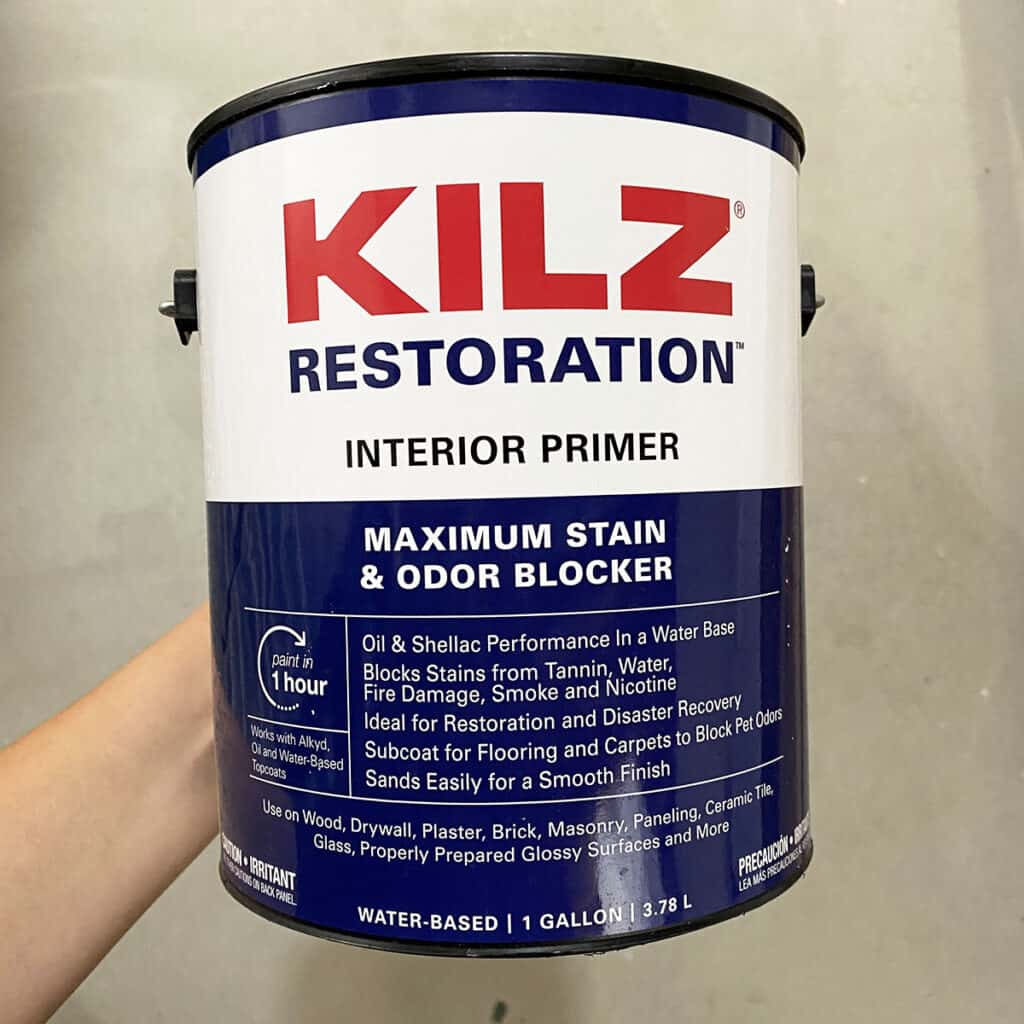
My guess is that it works about the same as Zinsser 123 primer.
| BIN Shellac Based Primer | Clear Shellac | Zinsser 123 | Cover Stain | |
|---|---|---|---|---|
| Adhesion | Excellent | Excellent | Good | Excellent |
| Prevents Bleedthrough | Excellent | Excellent | Good | Excellent |
| Coverage | Excellent | No | Excellent | Excellent |
| Odor | Strong Odor | Strong Odor | Low Odor | Strong Odor |
| Cleanup | Denatured Alcohol or Ammonia | Denatured Alcohol or Ammonia | Soap and Water | Mineral Spirits |
| Application | Brush, Roll, Spray Can | Spray Can | Brush, Roll, Spray | Brush, Roll, Spray |
| Tintable | Yes | No | Yes | Yes |
| What Kind of Paint / Topcoat | Any Type of Paint | Works Best with Mineral, Chalk, and Acrylic | Any Type of Paint | Oil and Latex |
| Dry Time Before Painting | 45 Minutes | 45 Minutes | 1 Hour | 1 Hour |
| Easy to Sand Soon After Dry | Sands to Powder | Sands to Powder | Sands to Powder | Gums Up Sandpaper |
| Interior / Exterior | Interior and Spot Exterior Use | Interior | Both | Both |
| Buy Now | Buy Now | Buy Now | Buy Now |
Best Primer for IKEA Furniture
Choosing the right primer for your IKEA furniture can be tricky – especially since they are made with so many different materials. First, consider the type of surface you’re working with.
If you’re painting laminate or plastic, for example, you’ll need a really good bonding primer that sticks well to any surface. Otherwise, you may find that the paint doesn’t adhere properly.
If it’s raw wood IKEA furniture, then you’ll need a good stain blocking primer to block bleedthrough, and a primer that gives a good layer of coverage.
If the wood has a topcoat on it, your primer will need to have excellent bonding properties.
- BIN shellac based primer covers all of these bases. It will stick to basically anything. It also blocks bleedthrough stains, and it provides great coverage for your paint. It also works with any paint, and it dries quickly. Additionally, it is easy to sand only an hour or so after you paint it on. It won’t gum up your sandpaper like oil based paints do. The biggest downside is that is has a strong odor and cleanup is with denatured alcohol or ammonia.
- STIX primer is great for laminate IKEA furniture since it has excellent adhesion to all the slick surfaces. But it doesn’t really block stains. So it’s not very good for wood furniture that has bleedthrough possibilities (mahogany, cherry and oak for sure.)
Check out this IKEA makeover to learn more about what to do and what not to do when painting IKEA furniture.
| BIN Shellac Based Primer | STIX | |
|---|---|---|
| Adhesion | Excellent | Excellent |
| Prevents Bleedthrough | Excellent | No |
| Coverage | Excellent | Excellent |
| Odor | Strong Odor | Low Odor |
| Cleanup | Denatured Alcohol or Ammonia | Soap and Water |
| Application | Brush, Roll, Spray Can | Brush, Roll, Spray |
| Tintable | Yes | Yes |
| What Kind of Paint / Topcoat | Any Type of Paint | Almost Any Type of Paint – Alkyd, Acrylic Latex, Urethane, Epoxy, and Lacquer Finishes |
| Dry Time Before Painting | 45 Minutes | 3-4 Hours |
| Easy to Sand Soon After Dry | Sands to Powder | Sands to Powder |
| Interior / Exterior | Interior and Spot Exterior Use | Both |
| Buy Now | Buy Now |
Best Primer for Dark Paint
When painting furniture a dark color, you probably don’t want to use a white primer, right? The white tinted primers will then make you have to paint more coats of the dark paint.
There are a few options when it comes to priming before using a dark colored paint…
- Aqua Lock primer comes in black! Aqua Lock primer has great adhesion properties (can be used on laminate furniture in conjunction with scuff sanding.) It also blocks some stains, but I don’t know that it is as good as a shellac-based or oil-based primer. It’s water-based so cleanup is easy, and the dry time is quick too. I’ve sprayed it (thinned 10%) and it sprays beautifully! I love this primer when painting with dark paint.
- Zinsser 123 gray base primer. Yep, the same Zinsser 123 primer we’ve been talking about comes in a gray tinted base. And it can be tinted additionally to be closer to the color you’re painting. You can get a much darker primer color if you start with and tint the gray base instead of the white base.
- Clear shellac is great to use on furniture when using dark colors because a lot of time the furniture is already dark wood. In these cases, I love to just have a clear primer and not change the color.
| Aqua Lock Primer in Black | Zinsser 123 Gray Base | Clear Shellac | |
|---|---|---|---|
| Adhesion | Great | Good | Excellent |
| Prevents Bleedthrough | Good | Good | Excellent |
| Coverage | Excellent | Excellent | No |
| Odor | Low Odor | Low Odor | Strong Odor |
| Cleanup | Soap and Water | Soap and Water | Denatured Alcohol or Ammonia |
| Application | Brush, Roll, Spray | Brush, Roll, Spray | Spray Can |
| Tintable | No | Yes | No |
| What Kind of Paint / Topcoat | Latex or Oil | Any Type of Paint | Works Best with Mineral, Chalk, and Acrylic |
| Dry Time Before Painting | 1 Hour | 1 Hour | 45 Minutes |
| Easy to Sand Soon After Dry | Sands to Powder | Sands to Powder | Sands to Powder |
| Interior / Exterior | Both | Both | Interior |
| Buy Now | Buy Now | Buy Now |
Best Primer for Painting Furniture Comparison
Here are the primers all lined up by each other so you can compare easier and decide which one is best for you and your project.
| BIN Shellac Based Primer | STIX | Clear Shellac | Zinsser 123 | Cover Stain | Aqua Lock Primer | |
|---|---|---|---|---|---|---|
| Adhesion | Excellent | Excellent | Excellent | Good | Excellent | Great |
| Prevents Bleedthrough | Excellent | No | Excellent | Good | Excellent | Good |
| Coverage | Excellent | Excellent | No | Excellent | Excellent | Excellent |
| Odor | Strong Odor | Low Odor | Strong Odor | Low Odor | Strong Odor | Low Odor |
| Cleanup | Denatured Alcohol or Ammonia | Soap and Water | Denatured Alcohol or Ammonia | Soap and Water | Mineral Spirits | Soap and Water |
| Application | Brush, Roll, Spray Can | Brush, Roll, Spray | Spray Can | Brush, Roll, Spray | Brush, Roll, Spray | Brush, Roll, Spray |
| Color | White | White | Clear | White or Gray | White | White or Black |
| Tintable | Yes | Yes | No | Yes | Yes | Yes and No |
| What Kind of Paint / Topcoat | Any Type of Paint | Almost Any Type of Paint – Alkyd, Acrylic Latex, Urethane, Epoxy, and Lacquer Finishes | Works Best with Mineral, Chalk, and Acrylic | Any Type of Paint | Oil and Latex | Latex or Oil |
| Dry Time Before Painting | 45 Minutes | 3-4 Hours | 45 Minutes | 1 Hour | 1 Hour | 1 Hour |
| Easy to Sand Soon After Dry | Sands to Powder | Sands to Powder | Sands to Powder | Sands to Powder | Gums Up Sandpaper | Sands to Powder |
| Interior / Exterior | Interior and Spot Exterior Use | Both | Interior | Both | Both | Both |
| Buy Now | Buy Now | Buy Now | Buy Now | Buy Now | Buy Now |
How long to let primer dry before painting furniture?
It depends on the type of primer you’re using, and it also depends on the temperature where you’re painting.
The hotter, and drier it is, the faster your primer will dry. If it is colder or humid, the primer will take longer to dry. Ideally, aim for 65 to 85 degrees Fahrenheit and low humidity.
If you are trying to block tannin bleedthrough, it’s better to let your primer dry overnight before painting. The longer dry time will help the primer block the stains.
| Dry Time Before Painting | |
|---|---|
| BIN Shellac Based Primer | 45 Minutes |
| Zinsser 123 Primer | 1 Hour |
| STIX | 3-4 Hours |
| Clear Shellac | 45 Minutes |
| Zinsser Cover Stain | 1 Hour |
| Aqua Lock Primer | 1 Hour |
Once the primer is dry, sand it lightly with fine grit sandpaper to smooth out any imperfections. Beware that if you use an oil based primer, the sandpaper will gum up if it’s not completely dry.
Waterbased and shellac based primers dry quickly and can easily be sanded an hour or so after application without the sandpaper gumming up.
Check out my list of the best water based primers here.
How many coats of primer on wood?
There isn’t a rule saying we need a specific amount of coats of primer before we paint.
One coat will probably be enough, but if you’re feeling meticulous, want the best coverage before you paint, or if you’re worried about bleedthrough, go ahead and apply a second coat after the first coat of primer is dry.
All in One Paint and Primer
You’ve probably seen all-in-one paint and primer paint in the paint aisles of your hardware store.
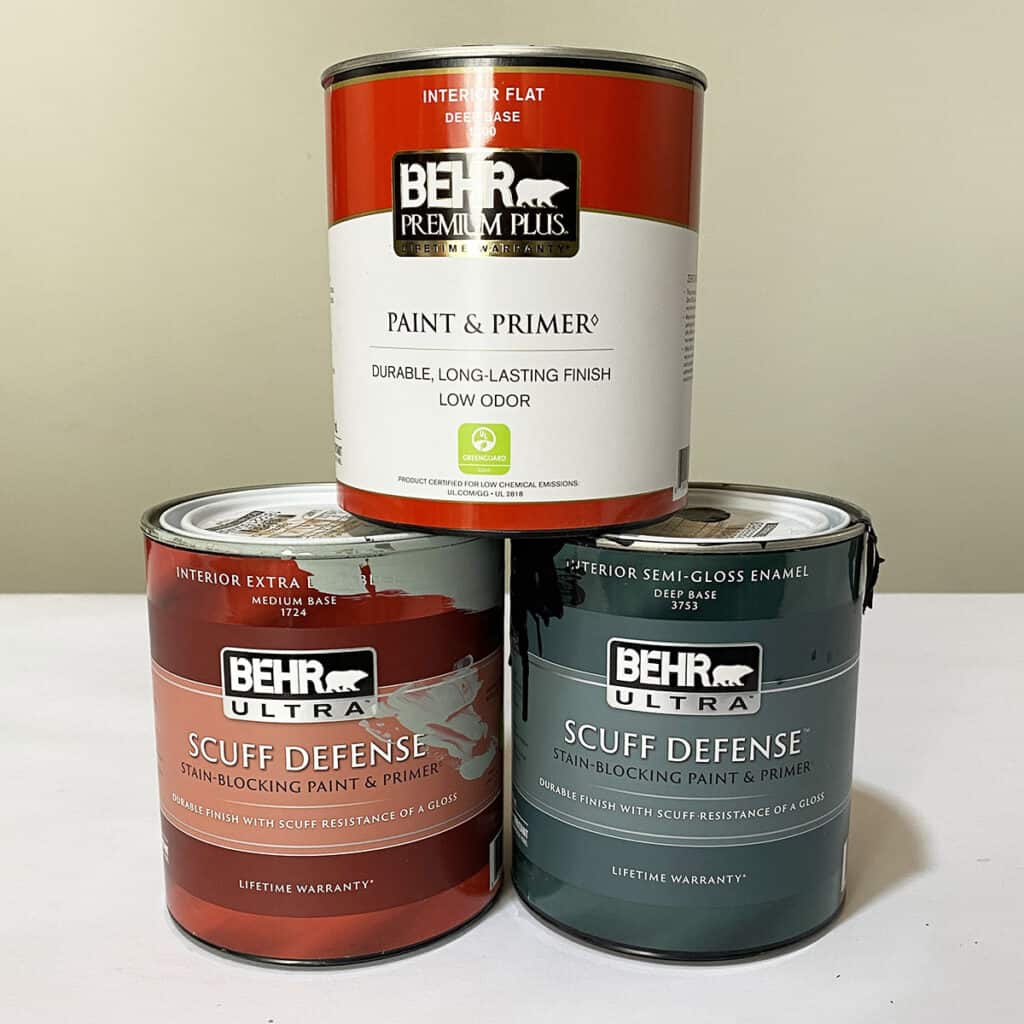
This is not the same as using primer. The primer in these paints is more to help with getting better coverage out of your paint.
But they don’t really help the paint adhere, or prevent bleedthrough stains like these other primers do.
Some furniture paints are called all in one paint and a lot of paints say they have a built-in primer. That’s great!
But 9 times out of 10, the built-in primer isn’t enough. You’ll need one of these real primers that I mentioned earlier. Learn more about all-in-one paint and primer paint here.
Can you use chalk paint as a primer?
No. Chalk paint doesn’t prevent bleedthrough stains, and it doesn’t have the excellent adhesion that these primers have.
Yeah, chalk paint has better adhesion than latex (wall) paint. But that’s about it. These primers mentioned above have far superior bonding, and stain blocking abilities.
99% of the time, even when I use chalk paint on furniture, I still use a primer before I paint the chalk paint on.
See how well chalk paint hold up without sanding or priming in this post about how to chalk paint furniture.
More Painting Furniture Resources
- Best Painting Furniture Supplies
- The Best Spray Paint for Wood Furniture
- Best Paint Brushes for Painting Furniture
- Best Sanders for Furniture
- How to Stop Wood Knots from Bleeding Through Paint
Follow us on YouTube to get more tips for painting furniture.
Or share your project with us on our Facebook Group and be part of our community. See you there!

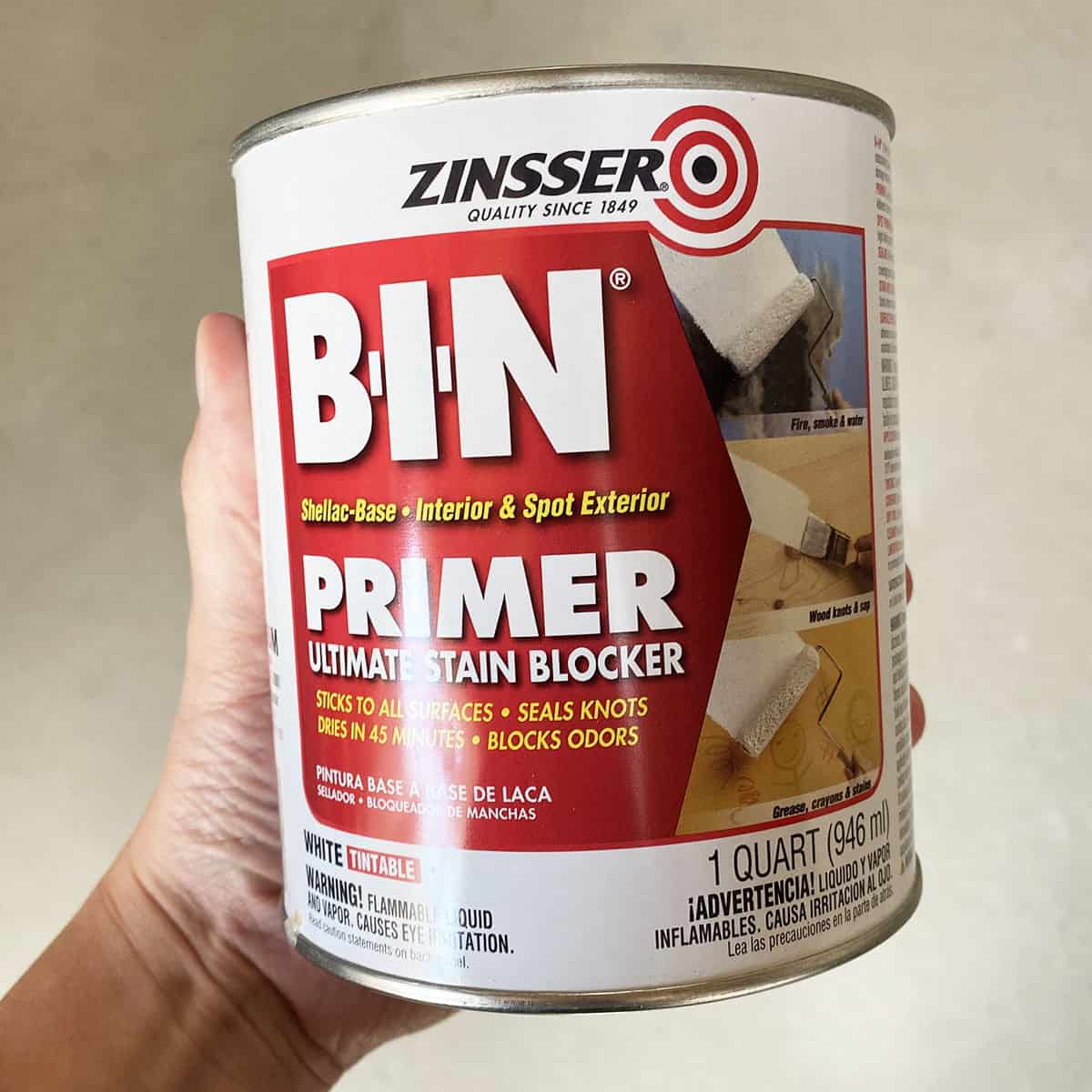
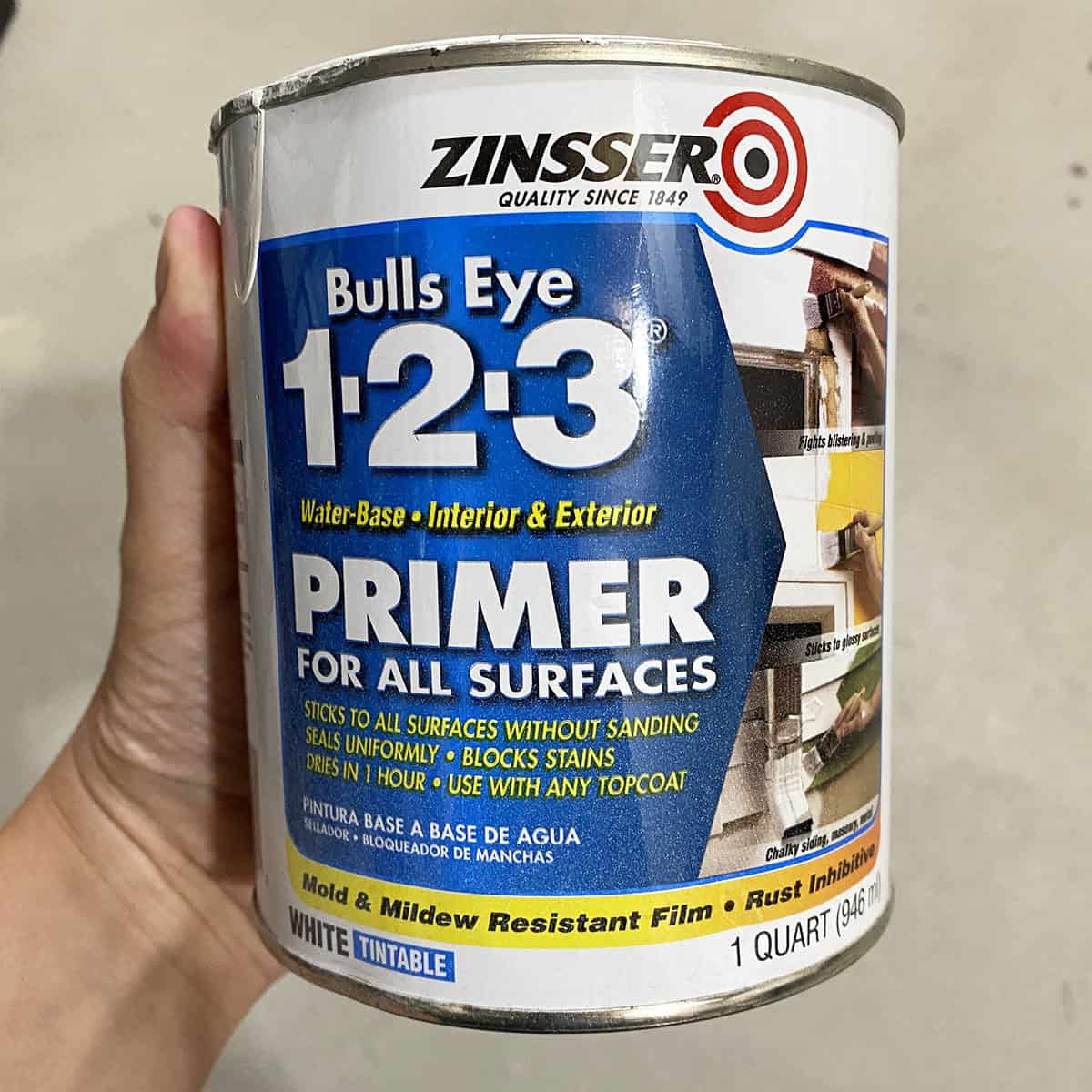
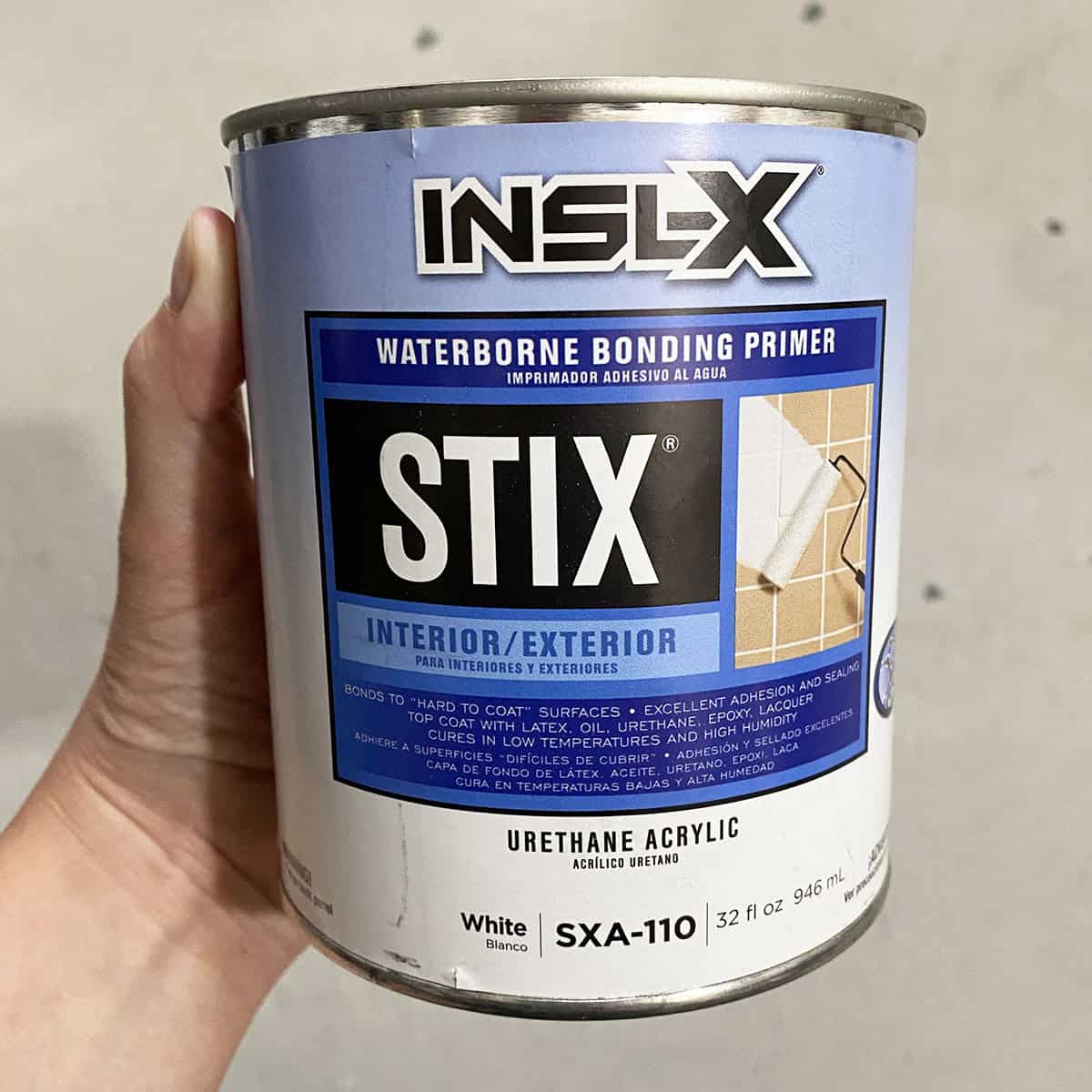
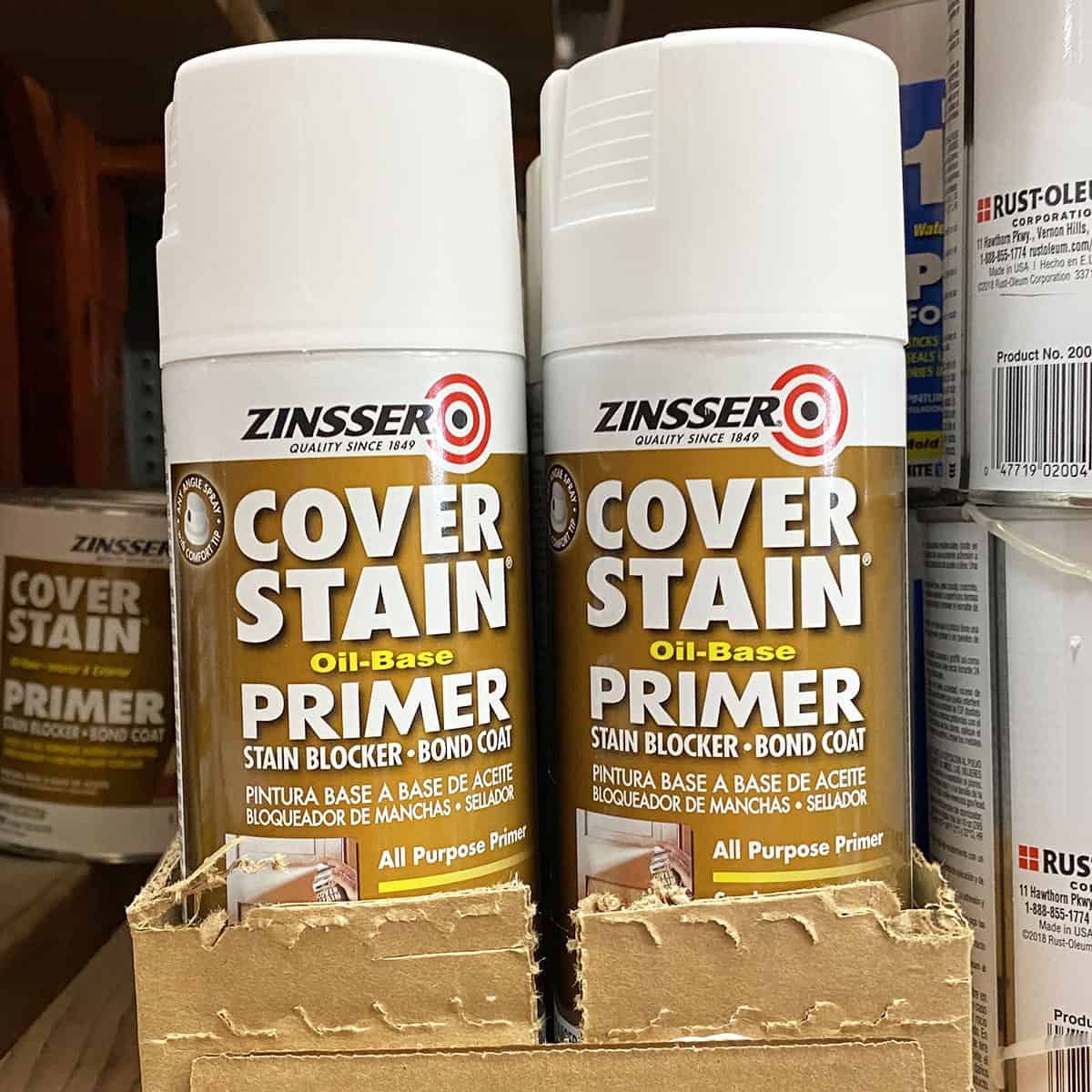
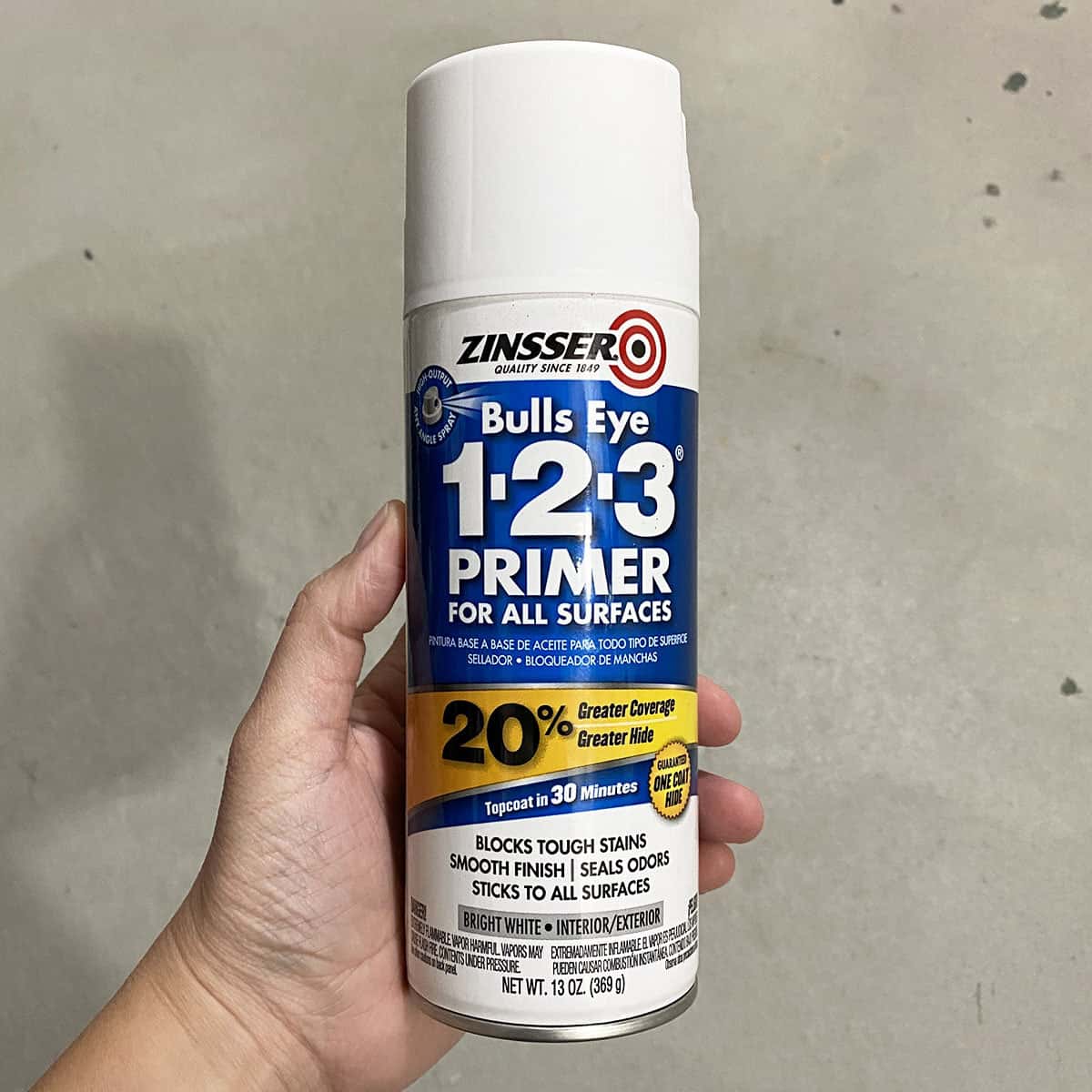
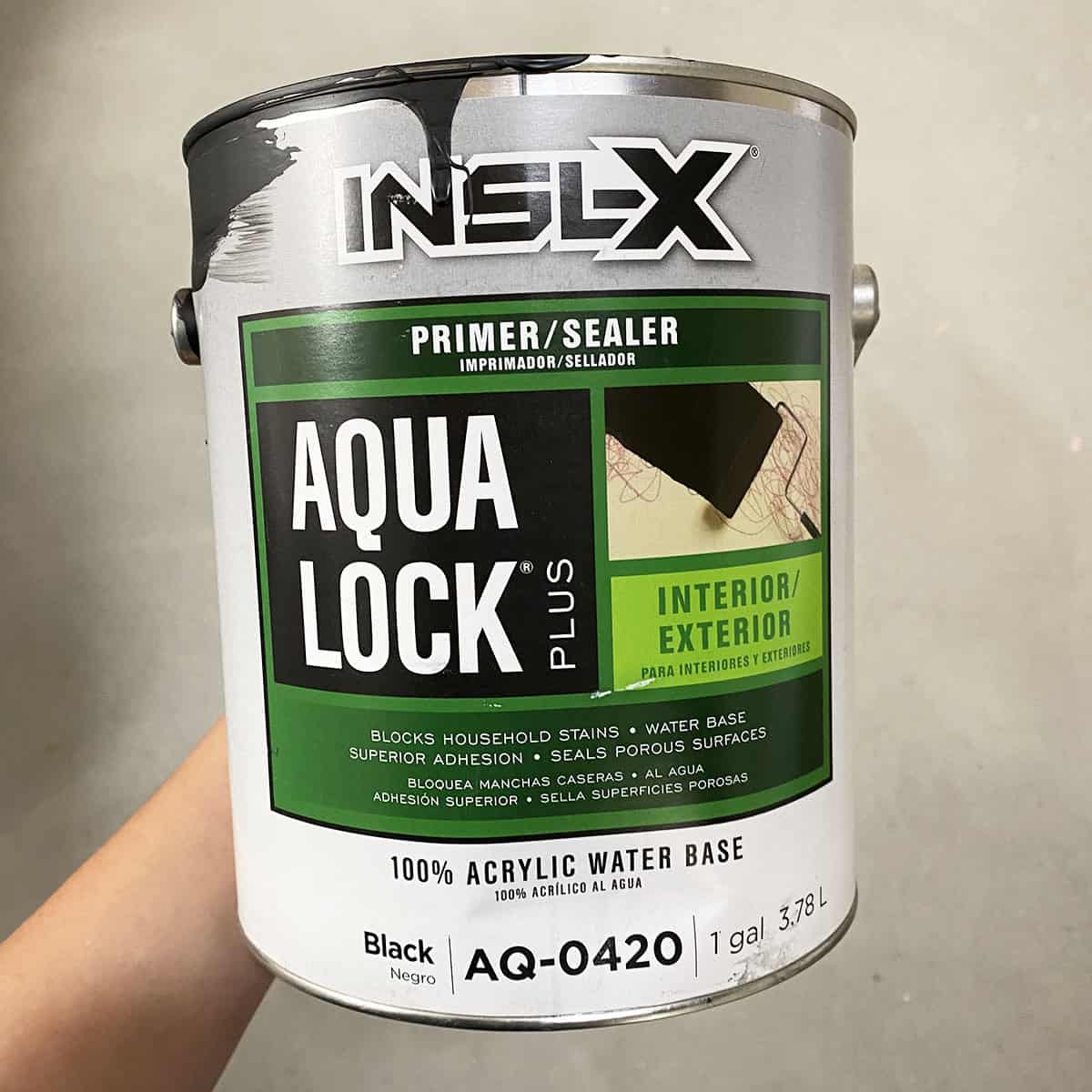
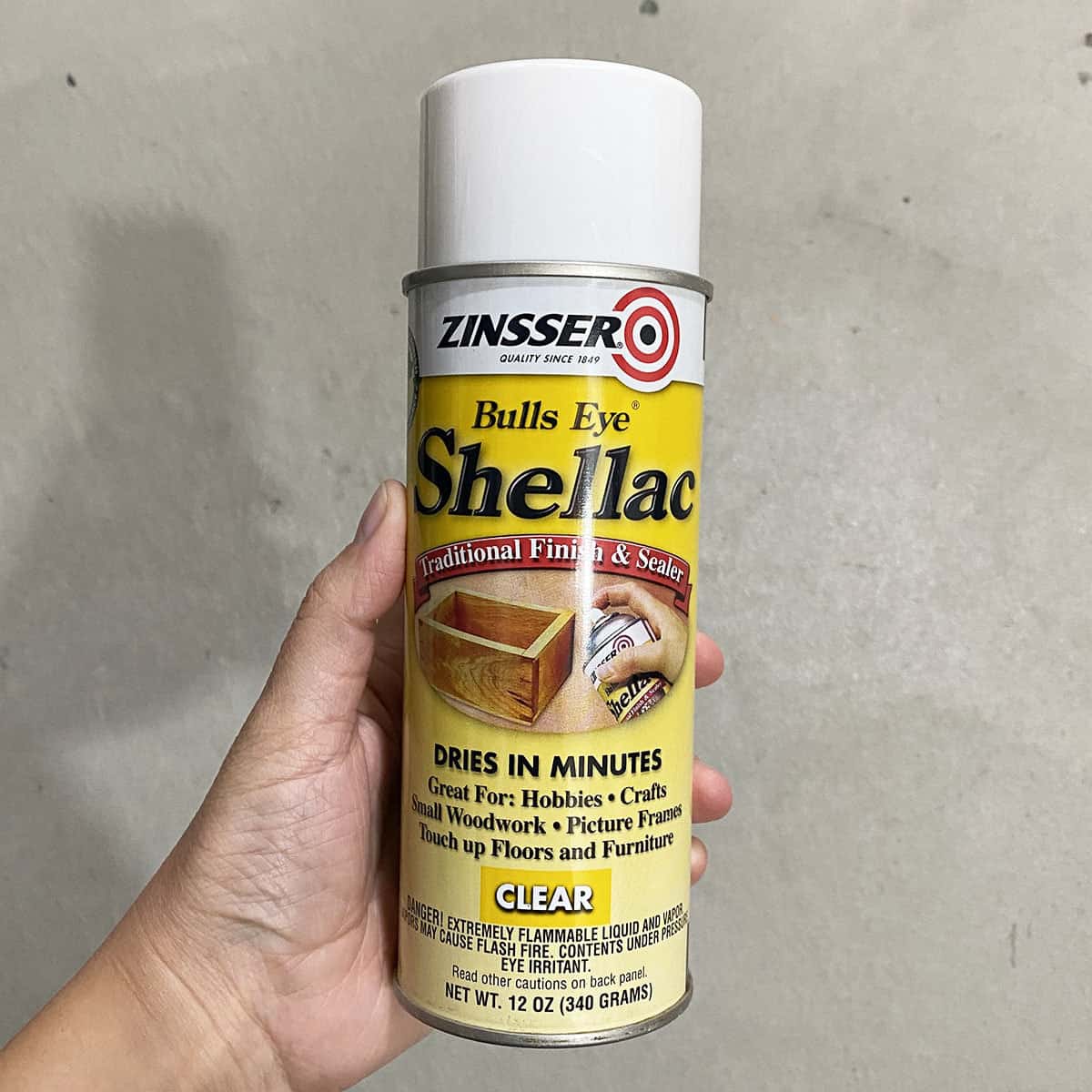
I have some family pieces that have old musty odors inside the drawers. I have tried numerous things to eliminate the smells with no luck. What paint would you recommend for the inside of the drawers and piece to block these odors?
Thanks!
I would recommend clear shellac. Here is more info on how to do it. How to Get Rid of Smoke Smell in Furniture
How many cans of the shellac spray primer would you say you need for a project like a wooden chest? Also, if I chose to go with the zinsser 123 primer and use my paint sprayer, would the primer need to be thinned at all in the sprayer?
I’m sure you would only need 1 can of BIN for the outside of a cedar chest.
Please do not thin 123 primer for your sprayer, it won’t adhere properly… ask me how I know. haha
I would really love to avoid clean ups involving alcohol or ammonia if I can! Is there a time you would use water-based primer and then spray shellac?
You can use water based primers! They just don’t work as well. But it’s possible!
Also, you can use the spray can of the shellac primers so you don’t have to clean up.
This is great information to have on hand. I’ve used Zinzzer BIN on Formica and plastic Melamine and dark stained wood cabinets. The Melamine cabinets in my kitchen were painted almost 18 years ago and are still beautiful. Two coats of Zinzzer BIN and 2 coats Ben Moore oil based paint and oil based glaze. They are a linen color. They look like painted wood. The 9’ vanity in my bathroom is oak that had been stained dark. Again, same treatment. Almost 18 yrs later there’s not one chip or scratch.
Oh thank you so much for taking the time to leave this comment! It’s so helpful to know they look great after all these years.